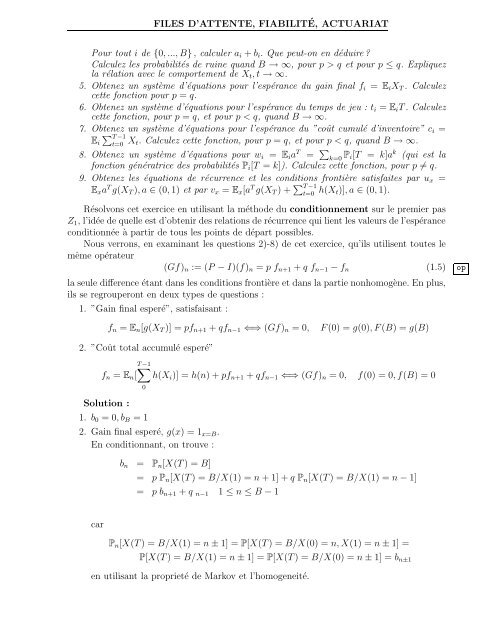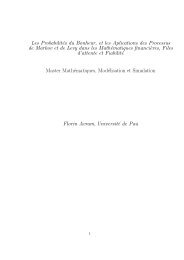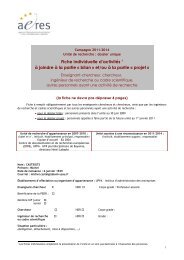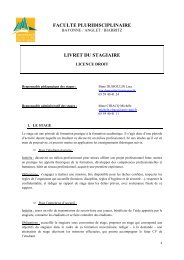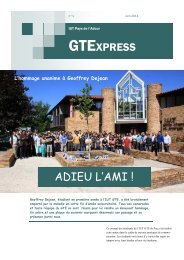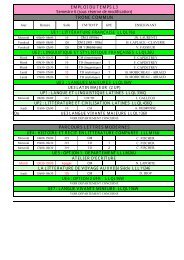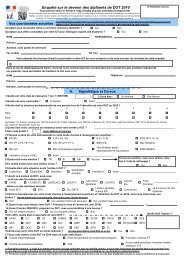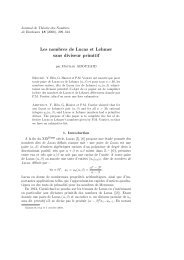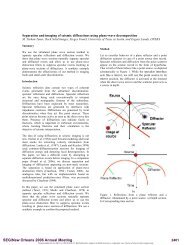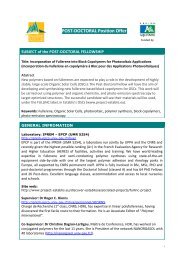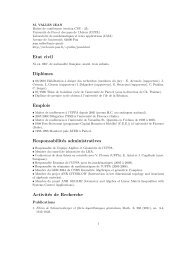Processus de Markov, de Levy, Files d'attente, Actuariat et Fiabilité ...
Processus de Markov, de Levy, Files d'attente, Actuariat et Fiabilité ...
Processus de Markov, de Levy, Files d'attente, Actuariat et Fiabilité ...
Create successful ePaper yourself
Turn your PDF publications into a flip-book with our unique Google optimized e-Paper software.
FILES D’ATTENTE, FIABILITÉ, ACTUARIAT<br />
Pour tout i <strong>de</strong> {0, ..., B}, calculer a i + b i . Que peut-on en déduire?<br />
Calculez les probabilités <strong>de</strong> ruine quand B → ∞, pour p > q <strong>et</strong> pour p ≤ q. Expliquez<br />
la rélation avec le comportement <strong>de</strong> X t , t → ∞.<br />
5. Obtenez un système d’équations pour l’espérance du gain final f i = E i X T . Calculez<br />
c<strong>et</strong>te fonction pour p = q.<br />
6. Obtenez un système d’équations pour l’espérance du temps <strong>de</strong> jeu : t i = E i T. Calculez<br />
c<strong>et</strong>te fonction, pour p = q, <strong>et</strong> pour p < q, quand B → ∞.<br />
7. Obtenez un système d’équations pour l’espérance du ”coût cumulé d’inventoire” c i =<br />
E i<br />
∑ T −1<br />
t=0 X t. Calculez c<strong>et</strong>te fonction, pour p = q, <strong>et</strong> pour p < q, quand B → ∞.<br />
8. Obtenez un système d’équations pour w i = E i a T = ∑ k=0 P i[T = k]a k (qui est la<br />
fonction génératrice <strong>de</strong>s probabilités P i [T = k]). Calculez c<strong>et</strong>te fonction, pour p ≠ q.<br />
9. Obtenez les équations <strong>de</strong> récurrence <strong>et</strong> les conditions frontière satisfaites par u x =<br />
E x a T g(X T ), a ∈ (0, 1) <strong>et</strong> par v x = E x [a T g(X T ) + ∑ T −1<br />
t=0 h(X t)], a ∈ (0, 1).<br />
Résolvons c<strong>et</strong> exercice en utilisant la métho<strong>de</strong> du conditionnement sur le premier pas<br />
Z 1 , l’idée <strong>de</strong> quelle est d’obtenir <strong>de</strong>s relations <strong>de</strong> récurrence qui lient les valeurs <strong>de</strong> l’espérance<br />
conditionnée à partir <strong>de</strong> tous les points <strong>de</strong> départ possibles.<br />
Nous verrons, en examinant les questions 2)-8) <strong>de</strong> c<strong>et</strong> exercice, qu’ils utilisent toutes le<br />
même opérateur<br />
(Gf) n := (P − I)(f) n = p f n+1 + q f n−1 − f n (1.5) op<br />
la seule difference étant dans les conditions frontière <strong>et</strong> dans la partie nonhomogène. En plus,<br />
ils se regrouperont en <strong>de</strong>ux types <strong>de</strong> questions :<br />
1. ”Gain final esperé”, satisfaisant :<br />
f n = E n [g(X T )] = pf n+1 + qf n−1 ⇐⇒ (Gf) n = 0,<br />
F(0) = g(0), F(B) = g(B)<br />
2. ”Coût total accumulé esperé”<br />
∑T −1<br />
f n = E n [ h(X i )] = h(n) + pf n+1 + qf n−1 ⇐⇒ (Gf) n = 0, f(0) = 0, f(B) = 0<br />
Solution :<br />
1. b 0 = 0, b B = 1<br />
0<br />
2. Gain final esperé, g(x) = 1 x=B .<br />
En conditionnant, on trouve :<br />
b n = P n [X(T) = B]<br />
= p P n [X(T) = B/X(1) = n + 1] + q P n [X(T) = B/X(1) = n − 1]<br />
= p b n+1 + q n−1 1 ≤ n ≤ B − 1<br />
car<br />
P n [X(T) = B/X(1) = n ± 1] = P[X(T) = B/X(0) = n, X(1) = n ± 1] =<br />
P[X(T) = B/X(1) = n ± 1] = P[X(T) = B/X(0) = n ± 1] = b n±1<br />
en utilisant la propri<strong>et</strong>é <strong>de</strong> <strong>Markov</strong> <strong>et</strong> l’homogeneité.


